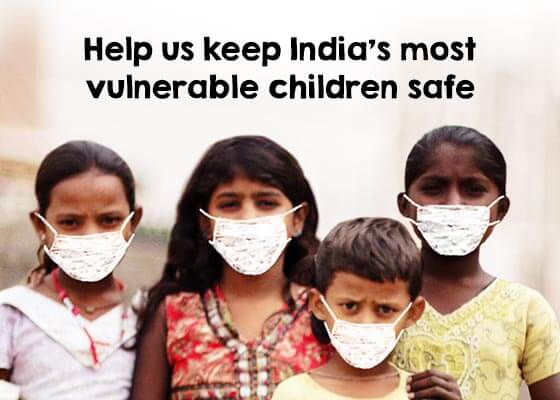‘Understanding The Effects of COVID-19 on Children’, a rapid online perception study conducted by CRY – Child Rights and You reveals how the pandemic-induced lockdown has affected children in many ways, according to a study by CRY. A report for Different Truths.
During the nationwide lockdown imposed as it was necessary to curb the spread of COVID-19 pandemic, nearly 50 per cent of the parents with children below five years of age in the households were not been able to access immunisation services, as revealed by a rapid online survey conducted by CRY – Child Rights and You, according to a media release.
During the nationwide lockdown imposed as it was necessary to curb the spread of COVID-19 pandemic, nearly 50 per cent of the parents with children below five years of age in the households were not been able to access immunisation services, as revealed by a rapid online survey conducted by CRY
Access to immunisation suffered a huge setback across all regions of the country. A whopping 63 per cent of the surveyed households in the northern states reported the lack of access to immunisation services, followed by West with 39 per cent; while less than a third of the respondents reported inaccessibility to immunisation from other regions.
One in every four (27 per cent) of the respondents, i.e. the parents / primary caregivers, reported non-accessibility of regular healthcare services for children during the lockdown – most reported from the North (31per cent), followed by the South (21per cent). In other regions, lack of access to regular healthcare facilities was experienced by less than 20 per cent of the parents, it was informed.
Even though children have not been the face of this pandemic as they have largely been spared of the direct health effects of COVID-19 so far, findings of the study indicate that they have been among its biggest victims
Even though children have not been the face of this pandemic as they have largely been spared of the direct health effects of COVID-19 so far, findings of the study indicate that they have been among its biggest victims with multiple side-effects on their physical and psycho-social well-being.
The study added that if access to basic healthcare for children was at bay, their access to education was affected equally during the lockdown days. Three in every four (77 per cent) of the respondents have reported that the lockdown has affected education and learning. This was again the highest in the North (87 per cent) and least in the West (56 per cent).
While 60 per cent of the parents / primary caregivers pointed out that among the regular activities for children affected were their extra-curricular opportunities; 60 per cent believed that children’s friendships and social lives were affected, and almost an equal section (59 per cent) perceived that children’s outdoor games and recreational opportunities were majorly compromised.
While 60 per cent of the parents / primary caregivers pointed out that among the regular activities for children affected were their extra-curricular opportunities; 60 per cent believed that children’s friendships and social lives were affected
More importantly, according to 37 per cent of the respondents, children’s psychological well-being and happiness have definitely been affected during this phase. This was most reported from the Eastern states (51 per cent), stated the media release.
A majority (88 per cent) of the respondents reported an increase in their children’s exposure to online activities (screen time), amongst which 45 per cent reported the increase to a great extent. Region-wise, in South, North, and West, around 40 per cent of the respondents reported that the screen time for the child had increased considerably.
Only 43 per cent of the parents reported about being able to watch their children’s online activity continuously. This was the highest in the West (68 per cent), followed by East (50 per cent). More than half of the respondents (52 per cent) reported about the provision of supervised access to the Internet for their children. One in every five respondents (22 per cent) reported about taking no measures to protect their children when online. This was the most reported form of North (25 per cent), it was added.
Only 43 per cent of the parents reported about being able to watch their children’s online activity continuously. This was the highest in the West (68 per cent), followed by East (50 per cent). More than half of the respondents (52 per cent) reported about the provision of supervised access to the Internet for their children.
The online perception study was conducted during the first and second phase of lockdown, based on responses of about 1100 parents / primary caregivers, from all across the country. Findings of the study were made public through a national webinar on 12th May. The webinar included a session where eminent experts took part and shared their insightful views and valuable opinions. The panel of experts included Dr. Raj Bhandari, (Member of National Technical Board of Nutrition and Health, GOI), Prof. Rekha Sharma Sen (Faculty of Child Development at IGNOU), Ms Swagata Raha (Legal researcher and child protection specialist) and Ms Rubina Maiti (State Education Officer – UNICEF, UP). The panel was moderated by Ms Puja Marwaha, the CEO at CRY, according to the media release.
Explaining the objective behind the study, Puja Marwaha, the CEO at CRY said, “As India entered the nationwide lockdown on 24th March, one of our very first thoughts was to engage ourselves in understanding the overall effect of COVID-19 on the children of our country. We are trying to provide essential services to the marginalised children and believe that soon we will all be returning to serve the children of our country, and for that, we need to be abreast with how their realities changed during this process.
Explaining the objective behind the study, Puja Marwaha, the CEO at CRY said, “As India entered the nationwide lockdown on 24th March, one of our very first thoughts was to engage ourselves in understanding the overall effect of COVID-19 on the children of our country…”
“In a country where 40 per cent of the total population are children, and the budget allocated for them is just a little over three per cent of the entire budget outlay, it is but obvious that they do not feature as the topmost topic of discussion while the country battles a pandemic. However, this most vulnerable section of the society has been one of the worst affected by the side-effects of COVID-19. To be able to address this, and to be better prepared to support the marginalised children of the country during and after the lockdown, we conducted the online survey in 23 States and Union Territories of India, to understand how the lockdown days have affected their physical and mental health, nutrition, education, protection and online security issues,” Puja added.
The survey reveals some other interesting trends as well. More than half of the respondents stated that they have bonded well with their children over household chores (54 per cent) and while watching movies (56 per cent) together. Only one in every 10 respondents reported that they were not been able to spend much time with their children during the lockdown. The percentage of parents or caregivers having open discussions with their children about the current situation was also considerably higher (54 per cent) than ones trying to divert their children’s minds from the reality (47 per cent).
One of the major recommendations of the study and expert panellists is to ensure essential child healthcare services through a combination of measures where the local governance can play a significant role. Very importantly, to keep children healthy (both physically and psychologically), parents should be provided with tools and techniques to monitor children’s behaviour and nutrition intake, and support if they notice any alarming change.
One of the major recommendations of the study and expert panellists is to ensure essential child healthcare services through a combination of measures where the local governance can play a significant role. Very importantly, to keep children healthy (both physically and psychologically), parents should be provided with tools and techniques to monitor children’s behaviour and nutrition intake, and support if they notice any alarming change. The situation of the poor and semi-poor households must be taken into account especially while planning and executing mitigation strategies, with a special focus on children, it was pointed out in the study.
Another important area the study harps on is online or virtual education through more systemic arrangements and logistical preparedness, thus creating options to provide uninterrupted learning opportunities to the children amidst the crisis. Since a large section of the society is still beyond the digital reach, it is imperative to uphold the spirit of inclusive education as enshrined in the RTE Act by ensuring that it reaches the children on the other side of the digital divide.
“This study is a sneak peek into the lives of our children under lockdown. We have drawn from it instances and ideas of how children have adapted to the situation and how it has affected their lives…”
“This study is a sneak peek into the lives of our children under lockdown. We have drawn from it instances and ideas of how children have adapted to the situation and how it has affected their lives. We hope that once the lockdown is over, we will be armed with necessary remedial measures to help India’s children get back on the road to a truly happy, healthy, creative and safe childhood,” Puja Marwaha concluded.
CRY_COVID-19_Study presentation
Infographics and tables sourced by CRY





 By
By
 By
By
 By
By